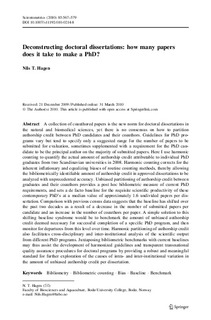| dc.contributor.author | Hagen, Nils Thorstein | |
| dc.date.accessioned | 2015-03-03T12:58:12Z | |
| dc.date.accessioned | 2015-03-09T12:13:19Z | |
| dc.date.available | 2015-03-03T12:58:12Z | |
| dc.date.available | 2015-03-09T12:13:19Z | |
| dc.date.issued | 2010 | |
| dc.identifier.citation | Hagen, N.T. (2010). Deconstructing doctoral dissertations: how many papers does it take to make a PhD? Scientometrics, 85(2), 567-579. doi: | nb_NO |
| dc.identifier.issn | 0138-9130 | |
| dc.identifier.uri | http://hdl.handle.net/11250/278730 | |
| dc.description.abstract | A collection of coauthored papers is the new norm for doctoral dissertations in the natural and biomedical sciences, yet there is no consensus on how to partition authorship credit between PhD candidates and their coauthors. Guidelines for PhD programs vary but tend to specify only a suggested range for the number of papers to be submitted for evaluation, sometimes supplemented with a requirement for the PhD candidate to be the principal author on the majority of submitted papers. Here I use harmonic counting to quantify the actual amount of authorship credit attributable to individual PhD graduates from two Scandinavian universities in 2008. Harmonic counting corrects for the inherent inflationary and equalizing biases of routine counting methods, thereby allowing the bibliometrically identifiable amount of authorship credit in approved dissertations to be analyzed with unprecedented accuracy. Unbiased partitioning of authorship credit between graduates and their coauthors provides a post hoc bibliometric measure of current PhD requirements, and sets a de facto baseline for the requisite scientific productivity of these contemporary PhD’s at a median value of approximately 1.6 undivided papers per dissertation. Comparison with previous census data suggests that the baseline has shifted over the past two decades as a result of a decrease in the number of submitted papers per candidate and an increase in the number of coauthors per paper. A simple solution to this shifting baseline syndrome would be to benchmark the amount of unbiased authorship credit deemed necessary for successful completion of a specific PhD program, and then monitor for departures from this level over time. Harmonic partitioning of authorship credit also facilitates cross-disciplinary and inter-institutional analysis of the scientific output from different PhD programs. Juxtaposing bibliometric benchmarks with current baselines may thus assist the development of harmonized guidelines and transparent transnational quality assurance procedures for doctoral programs by providing a robust and meaningful standard for further exploration of the causes of intra- and inter-institutional variation in the amount of unbiased authorship credit per dissertation. | nb_NO |
| dc.language.iso | eng | nb_NO |
| dc.publisher | Springer | nb_NO |
| dc.rights | Navngivelse-Ikkekommersiell 3.0 Norge | * |
| dc.rights.uri | http://creativecommons.org/licenses/by-nc/3.0/no/ | * |
| dc.title | Deconstructing doctoral dissertations : how many papers does it take to make a PhD? | nb_NO |
| dc.type | Journal article | nb_NO |
| dc.type | Peer reviewed | nb_NO |
| dc.date.updated | 2015-03-03T12:58:11Z | |
| dc.rights.holder | © 2010, The Author(s) | |
| dc.subject.nsi | VDP::Social science: 200::Library and information science: 320::Bibliometrics: 324 | nb_NO |
| dc.source.pagenumber | 567-579 | nb_NO |
| dc.source.volume | 85 | nb_NO |
| dc.source.journal | Scientometrics | nb_NO |
| dc.source.issue | 2 | nb_NO |
| dc.identifier.doi | 10.1007/s11192-010-0214-8 | |
| dc.identifier.cristin | 680772 | |
| dc.description.localcode | Paid Open Access | |

